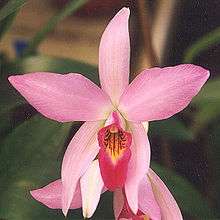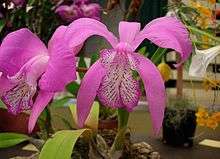Laelia
Laelia is a small genus of 25 species[1] in the orchid family (Orchidaceae). Laelia species are found in areas of subtropical or temperate climate in Central and South America, but mostly in Mexico.[2] Laelia is abbreviated L. in the horticultural trade.[3]
| Laelia | |
|---|---|
 | |
| Laelia anceps | |
| Scientific classification | |
| Kingdom: | Plantae |
| Clade: | Tracheophytes |
| Clade: | Angiosperms |
| Clade: | Monocots |
| Order: | Asparagales |
| Family: | Orchidaceae |
| Subfamily: | Epidendroideae |
| Tribe: | Epidendreae |
| Subtribe: | Laeliinae |
| Genus: | Laelia Lindl., 1831 |
| Type species | |
| Laelia speciosa (Kunth) Schltr. 1914 | |
| Species | |
|
See text | |
Description
Mostly epiphyte herbs (with a few lithophytes) with laterally compressed pseudobulbs.[2][4] One to four leathery or fleshy leaves are born near the top of each pseudobulb, and can be broadly ovate to oblong.[4] The inflorescence is a terminal raceme (rarely a panicle).[2][4] The flowers have 8 pollinia; petals are of a thinner texture than the sepals; sepals and petals are of similar shape, but the sepals being narrower; the lip or labellum is free from the arched flower column.[2][4]
Distribution
Species of Laelia can be found from western Mexico south to Bolivia, from sea level to mountain forests.[2][5]
Taxonomy
The genus Laelia was described as part of subfamily Epidendroideae by John Lindley.[6] Brazilian Laelias, after being classified for several years under Sophronitis,[7] have now been placed in the genus Cattleya.[8] Moreover, species formerly placed in the genus Schomburgkia have been moved either to the genus Laelia or Myrmecophila.[9]

Species
Laelia comprises the following species:[1]
| Image | Name | Distribution | Elevation (m) |
|---|---|---|---|
 | Laelia albida Bateman ex Lindl. 1839 | Mexico | 1000–2000 meters |
 | Laelia anceps Lindl. 1835 | Mexico and Honduras | 500 –1500 meters |
| Laelia aurea A.Navarro 1990 | Mexico ( Durango, Sinaloa and Nayarit ) | 200 meters | |
| Laelia autumnalis (Lex.) Lindl. 1831 | Mexico | 1500–2600 meters | |
 | Laelia colombiana J.M.H.Shaw 2008 | Colombia and Venezuela | |
_-_cropped.jpg) | Laelia elata (Schltr.) J.M.H.Shaw 2009 | Colombia | |
| Laelia eyermaniana Rchb.f. 1888 | Mexico (Nayarit, Michoacán, and Jalisco, Sonora, Chihuahua, Durango, Guanajuato, and Querétaro. Halbinger) | 1600–2600 meters | |
 | Laelia furfuracea Lindl. 1839 | Mexico (Oxaca) | 2100–3000 meters |
| Laelia gloriosa (Rchb.f.) L.O.Williams 1860 | Guyana, Venezuela, Colombia, Ecuador and northern Brazil | 200–850 meters | |
 | Laelia gouldiana Rchb.f. 1888 | Mexico Hidalgo | 1550 meters |
| Laelia × halbingeriana Salazar & Soto Arenas | Oaxaca, Mexico | 1160 meters | |
| Laelia heidii (Carnevali) Van den Berg & M.W.Chase 2004 | Colombia and Venezuela | ||
_-_cropped.jpg) | Laelia lueddemannii (Prill.) L.O.Williams 1940 | Costa Rica, Panama, Colombia and Venezuela | 0–600 meters |
| Laelia lyonsii (Lindl.) L.O.Williams 1941 | Cuba and Jamaica | 0–800 meters | |
 | Laelia marginata (Lindl.) L.O.Williams 1941 | Colombia, Venezuela, French Guyana, Guyana, Suriname and Northern Brazil | |
| Laelia mottae Archila, Chiron, Szlach. & Pérez-García 2014 | Guatemala | 400 meters | |
| Laelia moyobambae (Schltr.) C.Schweinf. 1944 | Bolivia and Peru | ||
 | Laelia rubescens Lindl. 1840 | Mexico, Guatemala, Belize, El Salvador, Honduras and Nicaragua | 0–1700 meters |
| Laelia schultzei (Schltr.) J.M.H.Shaw 2008 | Colombia | ||
 | Laelia speciosa (Kunth) Schltr. 1914 | Mexico | 1400–2400 meters |
| Laelia splendida (Schltr.) L.O.Williams 1941 | Colombia and Ecuador | 600–1500 meters | |
 | Laelia superbiens Lindl. 1840 | Mexico, Guatemala, Honduras and Nicaragua | 800–2000 meters |
 | Laelia undulata (Lindl.) L.O.Williams 1941 | Costa Rica, Panama, Colombia, Peru, Trinidad, Venezuela | 600–1200 meters |
| Laelia weberbaueriana (Kraenzl.) C.Schweinf. 1944 | Peru and Bolivia | 200–1300 meters | |
Ecology
Species in this genus are found in forests from sea level to mountain habitats above 2000 m.[2] Species from above 2000 m of elevation like L. albida, and L. autumnalis are adapted to temperate climates and can be grown outdoors in places like the Mexican Plateau, California and other subtropical areas with cool summers.[2]
Laelia is one of the orchid genera known to use crassulacean acid metabolism photosynthesis, which reduces evapotranspiration during daylight because carbon dioxide is collected at night.
Cultivation
Laelias can be grown fastened to tree trunks, as long as the tree won't cast a deep shadow; they can also be fastened to a piece of branch or a slab of cork so they can be hung in a place facing south.[2] The growing medium must have good drainage, rapidly drying after watering; pieces of pine bark, charcoal or pebbles are good choices.[2] If grown mounted they definitely need approximately 50–70% humidity, while cooler temperatures increase the blooming process.[10] Watering can be done 2–3 times a week, but with lower frequency in winter.[2] Fertilization can be done with a very dilute solution, twice a month especially during growing season (May to November in Northern Hemisphere).[2]
Nothogenera
Hybrids of Laelia with other orchid genera are placed in the following nothogenera (this list is incomplete):
- Laeliocattleya (Lc.) = Cattleya × Laelia
- Laeliocatonia (Lctna.) = Broughtonia × Cattleya × Laelia
- Laeliocatarthron (Lcr.) = Cattleya × Caularthron × Laelia
- Sophrolaelia (Sl.) = Laelia × Sophronitis
Rhyncholaelia is a distinct genus rather than a nothogenus.
References
- "Laelia (Orchidaceae) – The Plant List". Retrieved 9 May 2017.
- Halbinger, F.; Soto, M. (1997). "Laelias of Mexico". Orquídea. 15: 1–160.
- "Alphabetical list of standard abbreviations of all generic names occurring in current use in orchid hybrid registration as at 31st December 2007" (PDF). Royal Horticultural Society.
- Schweinfurth, C. (1960). "Orchids of Peru". Fieldiana. Chicago Natural History Museum. 30 (3): 536.
- Schweinfurth, C. (1970). "First supplement to the Orchids of Peru". Fieldiana. Field Museum of Natural History. 33: 46.
- John Lindley (1830–1840). The genera and species of orchidaceous plants. Ridgways; available from Biodiversity Heritage Library. p. 115.
- C. van den Berg; M. W. Chase (2000). "Nomenclatural notes on Laeliinae – I.". Lindleyana. 15 (2): 115–119.
- Berg, Cássio van den (2014). "Reaching a compromise between conflicting nuclear and plastid phylogenetic trees: a new classification for the genus Cattleya (Epidendreae; Epidendroideae; Orchidaceae)". Phytotaxa. 186 (2): 75–86. doi:10.11646/phytotaxa.186.2.2. ISSN 1179-3163.
- Allikas, Greg (September 2009). "Farewell Schomburgkia". American Orchid Society. Retrieved 20 November 2018.
- Thompson, Cable. "orchid care tips". Retrieved 4 February 2018.
External links
